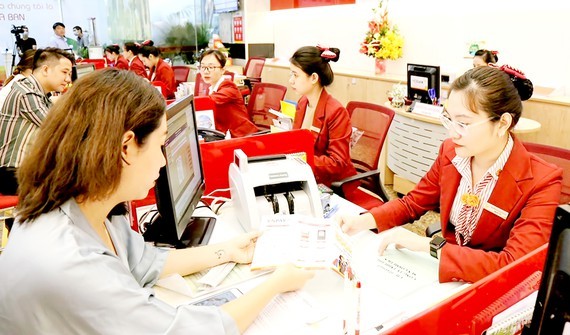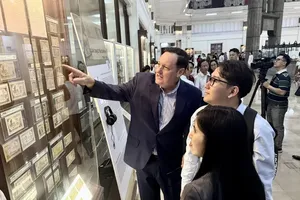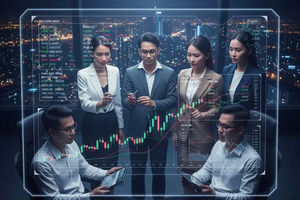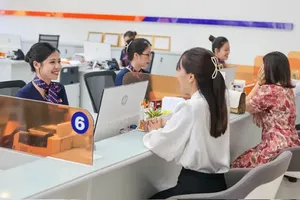 Customers do transactions at a commercial bank in HCMC. (Photo: SGGP)
Customers do transactions at a commercial bank in HCMC. (Photo: SGGP)
Money poured into real estate
According to the State Bank of Vietnam (SBV), by the end of the first quarter of this year, the credit outstanding balance of the economy exceeded VND9.46 quadrillion, up 2.93 percent compared to the end of last year. Noticeably, real estate credit rose 3 percent, higher than the general credit growth of the economy. Data from the Ministry of Construction also shows that credit outstanding balance for real estate investment and trading activities gradually surged quarter-by-quarter in 2020. Specifically, credit outstanding balance poured into real estate reached more than VND526.39 billion in the Q1 of last year, more than VND580.18 billion in Q2, more than VND606.25 billion in Q3, and VND633.47 billion in Q4.
Many experts said that the low deposit interest rates have urged a large amount of capital to flow into real estate, fueling these investment channels to grow strongly over the past months.
It is recorded that the average home loan interest rate at banks in the first 1-2 years is about 7-8 percent per annum, then being floated with an addition of 2-3 percent per annum, depending on the lender. Home loan interest rates at foreign bank branches alone are 1-3 percent per annum lower than those of domestic commercial banks. This interest rate level is considered reasonable for investment in the context that the real estate market is growing.
Ms. Thao Ngoc, a resident in District 2 in Ho Chi Minh City, said that she had a savings account with VND5 billion in the bank. However, because the deposit interest rate dropped heavily, while the lending interest rate was quite good, she decided to borrow another VND5 billion from the bank to invest in real estate. According to Ms. Ngoc, surfing the real estate wave with a profitability of about 20-30 percent is much better than bank deposits, so she made this decision. However, to get a bank loan, she and her husband had to prove their ability to repay their monthly debt by many different sources of income other than salary, such as rent, and even by the cash flow of recent real estate sales, through the bank account, Ms. Ngoc shared.
Regarding real estate credit, SBV Standing Deputy Governor Dao Minh Tu said that real estate credit is divided into two groups. The first group is real estate speculators and investors, who aim at high-end real estate projects which have low liquidity, so the SBV has the policy of restricting lending to these borrowers. For those who buy houses with low prices and commercial houses that serve their actual needs, banks still have policies to give them loans. Commercial banks always satisfy the essential and legitimate needs of people when they need consumer loans, including real estate consumption. The 3-percent credit growth in the first three months of this year was not seen in all credit institutions, but only in a few banks with faster real estate credit growth than before, Mr. Tu informed.
Strengthening tight control on cash flow
Many commercial banks said that real estate credit is not too alarming because most of the amount of money invested in real estate mainly comes from personal capital, so the real estate market is less risky. According to the leader of a branch of Vietcombank in Ho Chi Minh City, the bank still meets the capital needs for borrowers to buy homes and projects that the bank has associated with or provided credit guarantees. This lender hardly gives loans to speculators, especially in areas with high land prices, showing signs of land fever. “All credit loan contracts for this sector have collaterals and can only borrow as much as 70 percent of the value of the collaterals with extremely close valuations. Valuation is done by a specialized enterprise at the request of the bank. More importantly, borrowers have to prove the cash flow for repayment to get loans, he affirmed.
According to the State Bank of Vietnam (SBV), by the end of the first quarter of this year, the credit outstanding balance of the economy exceeded VND9.46 quadrillion, up 2.93 percent compared to the end of last year. Noticeably, real estate credit rose 3 percent, higher than the general credit growth of the economy. Data from the Ministry of Construction also shows that credit outstanding balance for real estate investment and trading activities gradually surged quarter-by-quarter in 2020. Specifically, credit outstanding balance poured into real estate reached more than VND526.39 billion in the Q1 of last year, more than VND580.18 billion in Q2, more than VND606.25 billion in Q3, and VND633.47 billion in Q4.
Many experts said that the low deposit interest rates have urged a large amount of capital to flow into real estate, fueling these investment channels to grow strongly over the past months.
It is recorded that the average home loan interest rate at banks in the first 1-2 years is about 7-8 percent per annum, then being floated with an addition of 2-3 percent per annum, depending on the lender. Home loan interest rates at foreign bank branches alone are 1-3 percent per annum lower than those of domestic commercial banks. This interest rate level is considered reasonable for investment in the context that the real estate market is growing.
Ms. Thao Ngoc, a resident in District 2 in Ho Chi Minh City, said that she had a savings account with VND5 billion in the bank. However, because the deposit interest rate dropped heavily, while the lending interest rate was quite good, she decided to borrow another VND5 billion from the bank to invest in real estate. According to Ms. Ngoc, surfing the real estate wave with a profitability of about 20-30 percent is much better than bank deposits, so she made this decision. However, to get a bank loan, she and her husband had to prove their ability to repay their monthly debt by many different sources of income other than salary, such as rent, and even by the cash flow of recent real estate sales, through the bank account, Ms. Ngoc shared.
Regarding real estate credit, SBV Standing Deputy Governor Dao Minh Tu said that real estate credit is divided into two groups. The first group is real estate speculators and investors, who aim at high-end real estate projects which have low liquidity, so the SBV has the policy of restricting lending to these borrowers. For those who buy houses with low prices and commercial houses that serve their actual needs, banks still have policies to give them loans. Commercial banks always satisfy the essential and legitimate needs of people when they need consumer loans, including real estate consumption. The 3-percent credit growth in the first three months of this year was not seen in all credit institutions, but only in a few banks with faster real estate credit growth than before, Mr. Tu informed.
Strengthening tight control on cash flow
Many commercial banks said that real estate credit is not too alarming because most of the amount of money invested in real estate mainly comes from personal capital, so the real estate market is less risky. According to the leader of a branch of Vietcombank in Ho Chi Minh City, the bank still meets the capital needs for borrowers to buy homes and projects that the bank has associated with or provided credit guarantees. This lender hardly gives loans to speculators, especially in areas with high land prices, showing signs of land fever. “All credit loan contracts for this sector have collaterals and can only borrow as much as 70 percent of the value of the collaterals with extremely close valuations. Valuation is done by a specialized enterprise at the request of the bank. More importantly, borrowers have to prove the cash flow for repayment to get loans, he affirmed.
 Customers see an apartment project in District 8. (Photo: SGGP)
Customers see an apartment project in District 8. (Photo: SGGP)
According to Dr. Can Van Luc, chief economist of BIDV, besides decreasing deposit interest rates, the real estate market has become hot as investors in the stock market have taken profits and poured into real estate. Particularly, many people have also switched investments to real estate because, in the past months, some provinces and cities have announced their planning, so investors thought that with planning, land prices would go up. Along with that, due to the pandemic, the production and business activities have slowed down in many places, leading to weak capital demand, so currently, the cheap capital flow is more plentiful than in the previous period. As a result, this cash flow poured into the most profitable channels, including real estate, helping this market to increase strongly. Assessing the real estate market, SBV First Deputy Governor Dao Minh Tu said that the central bank always pays attention and tightly controls the cash flow into risky sectors, including real estate, to promptly warn credit institutions when there are signs of instability. SBV has limited short-term capital mobilization rate for medium and long-term loans to a maximum of 40 percent, applied a risk ratio of 150 percent to loans with an outstanding balance of over VND4 billion that individuals borrow to serve consumer demand. Currently, the reasons that cause real estate prices to rise steeply in some provinces have been identified, assessed, and analyzed. Of which, land fever is caused by the announcements of new planning of some localities. Facing this situation, SBV has requested commercial banks to strengthen tight control on cash flows to ensure lending to the right subjects, in the right fields, restricting investment in risky fields. At the same time, they must closely monitor the use of loans of customers, avoid borrowing for other reasons but the nature of borrowings is to invest in real estate. Therefore, the reason for the growth in the real estate market is not from real estate credit. "To develop a healthy real estate market, avoid causing real estate bubbles, and ensure macro safety, besides tightening the cash flow of credit institutions, ministries and agencies should have synchronous policies for the real estate market,” said Mr. Dao Minh Tu.
Mr. Nguyen Hoang Minh, Head of the State Bank of Vietnam - Ho Chi Minh City branch:
Credit flows into real estate in HCMC remain under control
Real estate credit in HCMC has increased by about 2 percent compared to the end of last year, equivalent to the average increase of credit in the city. The real estate loan balance of HCMC-based credit institutions was about VND350 trillion, accounting for 13.5 percent of the total outstanding loans. The management of credit capital flows into real estate is still under control. Because commercial banks had learned the lessons of real estate lending during previous land fevers, so now, commercial banks are very cautious in lending to avoid bad debts, especially in the context that real estate prices climb sharply.
Dr. Le Minh Ngoc, finance-banking expert:
Investors need to calculate carefully when asking for bank loans
Real estate investors, F0 or Fn, who are planning to borrow money from banks to ride the real estate waves, need to take into account the possibility that interest rates will rise in the near future, and should also consider how much the profit, and how their financial endurance in case that they are unable to flee from the market. Even, those who buy residential real estate, especially those who are wage-earners and do not have backup financial resources, should also be cautious, especially if the buying decision is made solely because of the current low lending interest rates, which make the purchase of real estate on installments brighter and more feasible than ever. What they should do is to map out different interest rate increase scenarios and then calculate the monthly installment in comparison with total income to see if they can financially endure or not, and for how long. They should not think that interest rates will be controlled to not rise until things are out of control, it will easily lead to unfortunate consequences.
Credit flows into real estate in HCMC remain under control
Real estate credit in HCMC has increased by about 2 percent compared to the end of last year, equivalent to the average increase of credit in the city. The real estate loan balance of HCMC-based credit institutions was about VND350 trillion, accounting for 13.5 percent of the total outstanding loans. The management of credit capital flows into real estate is still under control. Because commercial banks had learned the lessons of real estate lending during previous land fevers, so now, commercial banks are very cautious in lending to avoid bad debts, especially in the context that real estate prices climb sharply.
Dr. Le Minh Ngoc, finance-banking expert:
Investors need to calculate carefully when asking for bank loans
Real estate investors, F0 or Fn, who are planning to borrow money from banks to ride the real estate waves, need to take into account the possibility that interest rates will rise in the near future, and should also consider how much the profit, and how their financial endurance in case that they are unable to flee from the market. Even, those who buy residential real estate, especially those who are wage-earners and do not have backup financial resources, should also be cautious, especially if the buying decision is made solely because of the current low lending interest rates, which make the purchase of real estate on installments brighter and more feasible than ever. What they should do is to map out different interest rate increase scenarios and then calculate the monthly installment in comparison with total income to see if they can financially endure or not, and for how long. They should not think that interest rates will be controlled to not rise until things are out of control, it will easily lead to unfortunate consequences.













)

)








